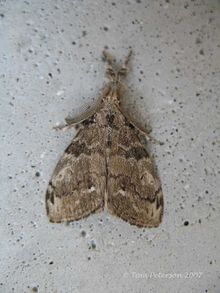- Orgyia leucostigma
-
White-marked tussock moth 
Adult 
Caterpillar in Mississippi (June) Conservation status Not evaluated (IUCN 3.1)Scientific classification Kingdom: Animalia Phylum: Arthropoda Class: Insecta Order: Lepidoptera Family: Lymantriidae Genus: Orgyia Species: O. leucostigma Binomial name Orgyia leucostigma
(JE Smith, 1797)Synonyms - Phalaena leucostigma Smith, 1797
- Hemerocampa leucostigma
- Cladophora leucographa Geyer, 1832
- Acyphas plagiata Walker, 1855
- Orgyia wardi Riotte, 1971
- Orgyia oslari Barnes, 1900
- Orgyia libera Strecker, 1900
Orgyia leucostigma, the White-marked tussock moth, is a moth in the family Lymantriidae. The caterpillar is very common especially in late summer in eastern North America, as far west as Texas, Colorado, and Alberta.
Contents
Life cycle
There are two or more generations a year in eastern North America (Wagner 2005). They overwinter in the egg stage.
Eggs
Eggs are laid in a single mass over the cocoon of the female, and covered in a froth (Wagner 2005). Up to 300 eggs are laid at a time.
Larvae
The larvae are brightly coloured, with tufts of hair-like setae. The head is bright red, the body has yellow or white stripes, with a black stripe along the middle of the back. There are bright red defensive glands on the hind end of the back. Four white toothbrush-like tufts stand out from the back, and there is a grey-brown hair pencil at the hind end. Touching the hairs will set off an allergic reaction in many humans (Wagner 2005). Young larvae skeletonize the surface of the leaf, while older larvae eat everything except the larger veins (Rose and Lindquist, 1982). They grow to about 35 mm.
Pupae
The caterpillars spin a grayish cocoon in bark crevices and incorporate setae in it (Rose and Lindquist, 1982). The moths emerge after 2 weeks.
Adults
The females have reduced wings and do not leave the vicinity of the cocoon. The males are grey with wavy black lines and a white spot on the forewings. (The vapourer, Orgyia antiqua, is similar but is a rusty colour.) The antennae are very feathery. Moths are found from June to October.
Host plants
The caterpillars may be found feeding on an extremely wide variety of trees, both deciduous and coniferous, including apple birch, black locust, cherry, elm, fir, hackberry, hemlock, hickory, larch, oak, rose, spruce, chestnut, and willow (Wagner 2005). Defoliating outbreaks are occasionally reported especially on Manitoba maple and elm in urban areas (Rose and Lindquist, 1982). Outbreaks are usually ended by viral disease.
Ecology
The fungus Entomophaga maimaiga was introduced to North America to control the gypsy moth Lymantria dispar. The fungus also infects O. leucostigma (Hajek et al., 2004) and could possibly have an impact in years when E. maimaiga is abundant. Large larvae are mostly attacked by birds, and small larvae mostly disappear during dispersal (Medina and Barbosa, 2002).
Subspecies
- Orgyia leucostigma leucostigma (South Carolina, from Georgia and Florida to Texas)
- Orgyia leucostigma intermedia Fitch, 1856 (from Maine and Ontario to Virginia, Alberta and Kansas)
- Orgyia leucostigma plagiata (Walker, 1855) (Nova Scotia, New Brunswick, Quebec)
- Orgyia leucostigma oslari Barnes, 1900 (New Mexico, Colorado)
- Orgyia leucostigma sablensis Niel, 1979 (Sable Island, Canada)
References
- Hajek AE, Strazanac JS, Wheeler MM, Vermeylen FM, Butler L. 2004. Persistence of the fungal pathogen Entomophaga maimaiga and its impact on native Lymantriidae. Biological Conytrol 30 (2): 466–473.
- Medina RF, Barbosa P. 2002. Predation of small and large Orgyia leucostigma (J.E. Smith) (Lepidoptera : Lymantriidae) larvae by vertebrate and invertebrate predators. Environmental Entomology 31: 1097–1102.
- Rose, AH and OH Lindquist. 1982. Insects of eastern hardwood tress. Canadian Forestry service, Forestry Tech Rep 29. Government of Canada, Ottawa. ISBN 0-660-11205-1.
- Wagner, DM. 2005. Caterpillars of eastern North America. Princeton University Press.
External links
External identifiers for Orgyia leucostigma EOL 2684210 Also found in: Wikispecies Categories:- Lymantriidae
- Butterflies and moths of North America
Wikimedia Foundation. 2010.
